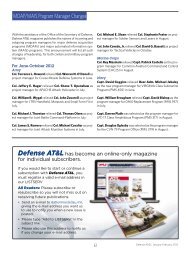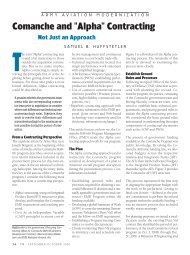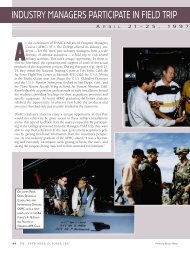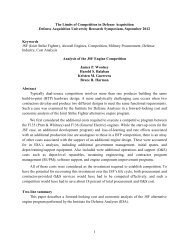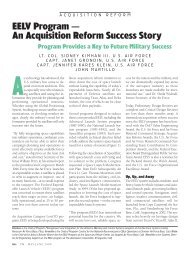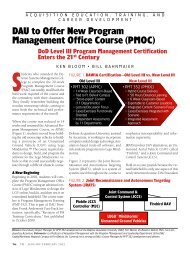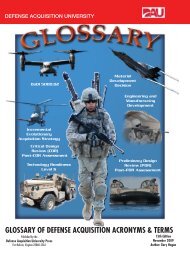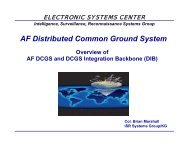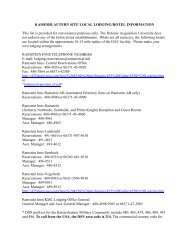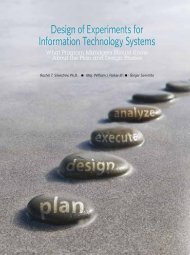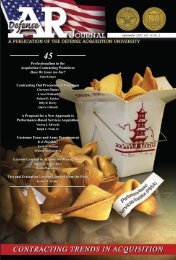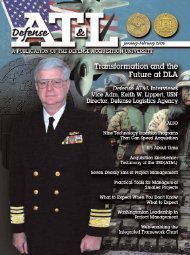Defense ARJ - Defense Acquisition University
Defense ARJ - Defense Acquisition University
Defense ARJ - Defense Acquisition University
Create successful ePaper yourself
Turn your PDF publications into a flip-book with our unique Google optimized e-Paper software.
HoW to Make incentiVe systeM of anD systeMs aWarD DeVeloPMent<br />
fees Work<br />
the period. In complex contracts, schedules often slip, so if the award fee period is<br />
based on time, and a significant event or outcome slips to another award fee period,<br />
the government could have an inappropriate amount of award fee available for the<br />
wrong reasons, thus not achieving the objectives of the award fee plan.<br />
Examples of evaluation periods linked to significant events are: (a) The F-15<br />
program tied the award fee periods to program milestones so the award fee periods<br />
varied from 6 to 9 months depending on when the milestones were reached; (b)<br />
Global Hawk added alignment with the contractor’s fiscal year; and (c) Both the<br />
Army’s Future Combat Systems and Total Integrated Engine Revitalization Program<br />
used cost-plus-fixed-fee (CPFF) contracts with incentive events.<br />
The events were tied to contract outcomes and varied with each period. These<br />
examples clearly indicate that when possible, evaluation periods should be linked to<br />
events or outcomes rather than time.<br />
feeDBack—sHoulD Be freQuent anD unaMBiGuous<br />
Feedback in incentive contracting is important, particularly in contracts with an<br />
award fee element because they require so much administration. The administrative<br />
burden can seem to be bureaucratic and excessive. However, the research results<br />
showed that monthly feedback within the joint government and contractor team was<br />
more effective than quarterly or biannual feedback. Continuous and open dialogue at<br />
both junior and senior levels led to early discovery and timely reconciliation of many<br />
known issues and helped keep the program on track. Many program offices empha-<br />
Continuous and open dialogue...led to early discovery and<br />
timely reconciliation of many known issues and helped keep<br />
the program on track.<br />
sized that they were very open with the contractor; therefore, the contractor was never<br />
surprised. Additionally, some programs instituted certain techniques like “emphasis<br />
letters” during the award fee periods to stress the importance of certain outcomes<br />
or events. One particular program office employed what they called a “barometer<br />
report” during interim reviews to ensure that information from monitors was readily<br />
available to manage at critical junctures.<br />
Several program offices found it necessary to establish a glossary, particularly<br />
for terms related to critical outcomes or events in incentives. The glossary was used<br />
as a tool to improve communication during the evaluation briefings. Glossaries were<br />
also beneficial when team member changes occurred. A good example for the use of<br />
glossaries occurred in the B-2 SPO on the Radar Modernization Program–Frequency<br />
Change contract. The program was in the systems development and demonstration<br />
139



